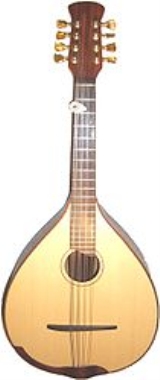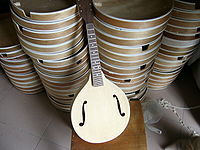
Mandola
Encyclopedia
The mandola or tenor mandola (Ireland, and UK) is a fretted, stringed
musical instrument
. It is to the mandolin what the viola is to the violin: the four double courses of strings tuned in fifths to the same pitches as the viola
(C-G-D-A low-to-high), a fifth lower than a mandolin
. However, the mandola, although now rarer, is the ancestor of the mandolin, the name of which means simply "little mandola".
The name mandola may originate with the ancient pandura
, and was also rendered as mandora
, the change perhaps having been due to approximation to the Italian word for "almond". The instrument developed from the lute
at an early date, being more compact and cheaper to build, but the sequence of development and nomenclature in different regions is now hard to discover. Historically related instruments include the mandore
, mandole, pandurina, bandurina, and—in 16th century Germany—the quinterne
or chiterna. However, significantly different instruments have at times and places taken on the same or similar names, and the "true" mandola has been strung in several different ways.
The mandola has four double courses of metal strings, tuned in unison rather than in octaves. The scale length is typically around 42 cm (16.5 inches). The mandola is typically played with a plectrum
. The double strings accommodate a sustaining technique called tremolando, a rapid alternation of the plectrum on a single course of strings.
Mandolas are not uncommon in folk music
, (particularly Italian folk music
) and sometimes used in Irish traditional music
, although far less often, in the latter case, than the octave mandola, Irish bouzouki
, and modern cittern
. Some Irish traditional musicians, such as Andy Irvine
restring the tenor mandola with lighter strings and tune it as a mandolin
, while others (Brian McDonagh of Dervish
being the best known) use altered tunings such as D-A-E-A. Like the guitar
the mandola can be acoustic or electric. Attila the Stockbroker
, punk poet and frontman of Barnstormer, uses an electric mandola as his main instrument. Alex Lifeson, guitarist of Rush
, has also featured the mandola in his work.

String instrument
A string instrument is a musical instrument that produces sound by means of vibrating strings. In the Hornbostel-Sachs scheme of musical instrument classification, used in organology, they are called chordophones...
musical instrument
Musical instrument
A musical instrument is a device created or adapted for the purpose of making musical sounds. In principle, any object that produces sound can serve as a musical instrument—it is through purpose that the object becomes a musical instrument. The history of musical instruments dates back to the...
. It is to the mandolin what the viola is to the violin: the four double courses of strings tuned in fifths to the same pitches as the viola
Viola
The viola is a bowed string instrument. It is the middle voice of the violin family, between the violin and the cello.- Form :The viola is similar in material and construction to the violin. A full-size viola's body is between and longer than the body of a full-size violin , with an average...
(C-G-D-A low-to-high), a fifth lower than a mandolin
Mandolin
A mandolin is a musical instrument in the lute family . It descends from the mandore, a soprano member of the lute family. The mandolin soundboard comes in many shapes—but generally round or teardrop-shaped, sometimes with scrolls or other projections. A mandolin may have f-holes, or a single...
. However, the mandola, although now rarer, is the ancestor of the mandolin, the name of which means simply "little mandola".
The name mandola may originate with the ancient pandura
Pandura
The pandura is an ancient Greek string instrument from the Mediterranean basin.It is derived from pandur, a Sumerian term for long-necked lutes...
, and was also rendered as mandora
Mandora
A mandora is a type of lute. The terms referred to different instruments at different periods in history.-Treble instrument:During the Renaissance, the term mandore was applied to the treble lute and in such usage it is difficult to distinguish from the mandola, the simple lute that is the ancestor...
, the change perhaps having been due to approximation to the Italian word for "almond". The instrument developed from the lute
Lute
Lute can refer generally to any plucked string instrument with a neck and a deep round back, or more specifically to an instrument from the family of European lutes....
at an early date, being more compact and cheaper to build, but the sequence of development and nomenclature in different regions is now hard to discover. Historically related instruments include the mandore
Mandore (instrument)
The mandore was mentioned as a new instrument in French music books from the 1580s. It was a small member of the lute family, teardrop shaped, with four, five or six courses of gut strings and pitched in the treble range. It is considered ancestral to the modern mandolin and has also been called...
, mandole, pandurina, bandurina, and—in 16th century Germany—the quinterne
Gittern
The gittern was a relatively small, quill-plucked, gut strung instrument that originated around the 13th century and came to Europe via Moorish Spain. It was also called the quinterne in Germany, the guitarra in Spain, and the chitarra in Italy...
or chiterna. However, significantly different instruments have at times and places taken on the same or similar names, and the "true" mandola has been strung in several different ways.
The mandola has four double courses of metal strings, tuned in unison rather than in octaves. The scale length is typically around 42 cm (16.5 inches). The mandola is typically played with a plectrum
Plectrum
A plectrum is a small flat tool used to pluck or strum a stringed instrument. For hand-held instruments such as guitars and mandolins, the plectrum is often called a pick, and is a separate tool held in the player's hand...
. The double strings accommodate a sustaining technique called tremolando, a rapid alternation of the plectrum on a single course of strings.
Mandolas are not uncommon in folk music
Folk music
Folk music is an English term encompassing both traditional folk music and contemporary folk music. The term originated in the 19th century. Traditional folk music has been defined in several ways: as music transmitted by mouth, as music of the lower classes, and as music with unknown composers....
, (particularly Italian folk music
Italian folk music
Italian folk music has a deep and complex history. National unification came quite late to the Italian peninsula, so its many hundreds of separate cultures remained un-homogenized until quite recently compared to many other European countries...
) and sometimes used in Irish traditional music
Folk music of Ireland
The folk music of Ireland is the generic term for music that has been created in various genres in Ireland.-History:...
, although far less often, in the latter case, than the octave mandola, Irish bouzouki
Irish bouzouki
The Irish bouzouki is a development of the octave mandolin adapted for Irish traditional and other folk music from the late 1960s onward.-Adoption for Celtic music:...
, and modern cittern
Cittern
The cittern or cither is a stringed instrument dating from the Renaissance. Modern scholars debate its exact history, but it is generally accepted that it is descended from the Medieval Citole, or Cytole. It looks much like the modern-day flat-back mandolin and the modern Irish bouzouki and cittern...
. Some Irish traditional musicians, such as Andy Irvine
Andy Irvine (musician)
Andrew Kennedy 'Andy' Irvine is a folk musician, singer, and songwriter, and a founding member of the popular band Planxty. He is an accomplished player of the mandolin, bouzouki, mandola, guitar-bouzouki, harmonica and hurdy-gurdy....
restring the tenor mandola with lighter strings and tune it as a mandolin
Mandolin
A mandolin is a musical instrument in the lute family . It descends from the mandore, a soprano member of the lute family. The mandolin soundboard comes in many shapes—but generally round or teardrop-shaped, sometimes with scrolls or other projections. A mandolin may have f-holes, or a single...
, while others (Brian McDonagh of Dervish
Dervish (band)
Dervish are a traditional Irish music group from County Sligo, Ireland. They were formed in 1989 by Liam Kelly, Shane Mitchell, Martin McGinley, Brian McDonagh and Michael Holmes. The band was originally formed to record an album of local music which was later released as “The Boys of Sligo”. They...
being the best known) use altered tunings such as D-A-E-A. Like the guitar
Guitar
The guitar is a plucked string instrument, usually played with fingers or a pick. The guitar consists of a body with a rigid neck to which the strings, generally six in number, are attached. Guitars are traditionally constructed of various woods and strung with animal gut or, more recently, with...
the mandola can be acoustic or electric. Attila the Stockbroker
Attila the Stockbroker
Attila the Stockbroker is a punk poet, and a folk punk musician and songwriter. He performs solo and as the leader of the band Barnstormer...
, punk poet and frontman of Barnstormer, uses an electric mandola as his main instrument. Alex Lifeson, guitarist of Rush
Rush (band)
Rush is a Canadian rock band formed in August 1968, in the Willowdale neighbourhood of Toronto, Ontario. The band is composed of bassist, keyboardist, and lead vocalist Geddy Lee, guitarist Alex Lifeson, and drummer and lyricist Neil Peart...
, has also featured the mandola in his work.
See also

- MandolinMandolinA mandolin is a musical instrument in the lute family . It descends from the mandore, a soprano member of the lute family. The mandolin soundboard comes in many shapes—but generally round or teardrop-shaped, sometimes with scrolls or other projections. A mandolin may have f-holes, or a single...
- Mando-bass
- Octave mandola - Tuned an octave below the mandolin
- MandocelloMandocelloThe mandocello is a plucked string instrument of the mandolin family. It has eight strings in four paired courses, tuned in 5ths like a mandolin, but is larger, and tuned CC-GG-dd-aa . It is to the mandolin what the cello is to the violin.-Construction:Mandocello construction is similar to the...
- Tuned an octave below the mandola - Irish bouzoukiIrish bouzoukiThe Irish bouzouki is a development of the octave mandolin adapted for Irish traditional and other folk music from the late 1960s onward.-Adoption for Celtic music:...

